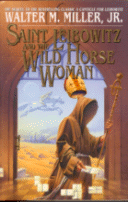St. Liebowitz and the Wild Horse Woman Review
St. Liebowitz and the Wild Horse Womanby Walter M. Miller,. Jr.
Bantam Books, Nov., 1997.
Paperback, 432 pages.
ISBN: 0553107046.
Ordering information: Amazon.com.
 After Walter Miller wrote his classic work, A Canticle for
Leibowitz, he virtually disappeared from the literary
scene. A recluse, Miller, despite overwhelming requests
from his fans, refused to publish another work. Finally,
in 1989, he agreed to write a second novel. In 1995 it
became clear to Miller, who was in his 70s, that he was
unable to finish the last 100 pages of the book he had
been working on for seven years. He hired noted science
fiction writer Terry Bisson to complete the book using Miller's
outline and scripted dialogue. Tragically, Miller committed
suicide soon after. Bisson persevered and the result is Saint
Leibowitz and the Wild Horse Woman, a tale set in the
34th century of the world described in A Canticle for
Leibowitz. Bisson did an excellent job on a difficult task;
his work is truly transparent.
After Walter Miller wrote his classic work, A Canticle for
Leibowitz, he virtually disappeared from the literary
scene. A recluse, Miller, despite overwhelming requests
from his fans, refused to publish another work. Finally,
in 1989, he agreed to write a second novel. In 1995 it
became clear to Miller, who was in his 70s, that he was
unable to finish the last 100 pages of the book he had
been working on for seven years. He hired noted science
fiction writer Terry Bisson to complete the book using Miller's
outline and scripted dialogue. Tragically, Miller committed
suicide soon after. Bisson persevered and the result is Saint
Leibowitz and the Wild Horse Woman, a tale set in the
34th century of the world described in A Canticle for
Leibowitz. Bisson did an excellent job on a difficult task;
his work is truly transparent.
Saint Leibowitz and the Wild Horsewoman tells the tale of Monk Blacktooth St. George. An unhappy resident of the Leibowitz Abbey, St. George is suffering a crisis in faith struggling between the dictates of his Nomad upbringing and his religious vows and his increasingly secular visions of the wild horsewoman, a myth from his childhood. Offered a way out of the Abbey without renouncing his vows (which would result in him becoming a pariah, St. George is assigned to be the translator for Cardinal Brownpony. Traveling with Cardinal Brownpony to New Rome for the election of a new Pope he is thrust into a maelstrom of political intrigue and secular temptations, long forbidden by his vows.
St. Leibowitz and the Wild Horsewoman is a longer and more complex tale than A Canticle for Leibowitz, more of a close-up view of one time period out of the many covered in the original novel. The humor, the symbolism and the social commentary are vintage Miller, although the pace is much slower and the supporting cast is much larger than that found in A Canticle for Leibowitz. Miller's storytelling skills still shine and his characters pulse with eccentric life. An intriguing tale from a talented, yet troubled, author.
Return to the February 1998 issue of The IWJ.
More from Writers Write
